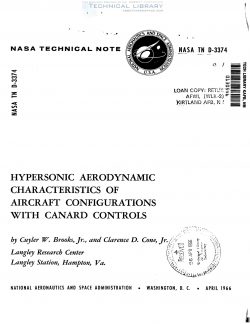NASA-TN-D-3374
- Version
- 40 Downloads
- 4.85 MB File Size
- 1 File Count
- May 24, 2017 Create Date
- May 24, 2017 Last Updated
NASA, Technical Memorandum - Hypersonic Aerodynamic Characteristics of Aircraft Configurations with Canard Controls

An experimental investigation of the aerodynamic characteristics of a canard-
control, wing-body configuration having a 70°— Swept— delta wing was made at a Mach num-
ber of 10.03 in the Langley hypersonic flow apparatus. The effects of canard size and
planform, body length, wing position, and vertical-tail position on the longitudinal, lateral,
and directional characteristics were determined.
The results indicate that the stability and lift characteristics of these configurations
are nonlinear because of the nature of the hypersonic flow regime; these experimental
nonlinearities are qualitatively predicted by Newtonian impact theory. However, the
effects of canard deflection and wing vertical position on the variation of lift coefficient
with angle of attack indicate that there is a measurable interference effect of the canard
shock field and/ or wake on the flow under the high wing.
Canard control effectiveness is somewhat greater for the trapezoidal than for the
delta canard. Canard control effectiveness also increases with body length (canard
moment arm) for the high—wing configurations, whereas for the low-wing configurations
an increase is found only for the highest canard deflection.
The canards have negligible effects on the lateral and directional stability of the
configurations except at the higher angles of attack. The vertical tails are directionally
stabilizing, as would be expected, but the dihedral effect of the vertical tails is dependent
on the wing vertical position. The high-wing configurations are considerably more stable
laterally and directionally than the corresponding low-wing configurations.
There has been considerable interest in the past in the use of canard controls at
supersonic Mach numbers because of the greater control effectiveness and high maximum
lift- drag ratios obtainable with these controls compared with those obtainable with con—
ventional aft-tail controls. (See refs. 1 to 4.) In experimental investigations of various
hypersonic configurations, it has been found that conventional rearward pitch controls
lose effectiveness when they come within the hypersonic "shadow region." (See ref. 5.)
Since canard controls are not subject to this blanketing effect, because of their forward
location, and since canards have been found to be effective control devices at supersonic
speeds, the question of their value at the higher Mach numbers for use in various hyper-
sonic cruise—vehicle concepts is of interest.
| File | Action |
|---|---|
| NASA-TN-D-3374 Hypersonic Aerodynamic Characteristics of Aircraft Configurations with Canard Controls.pdf | Download |
Comment On This Post